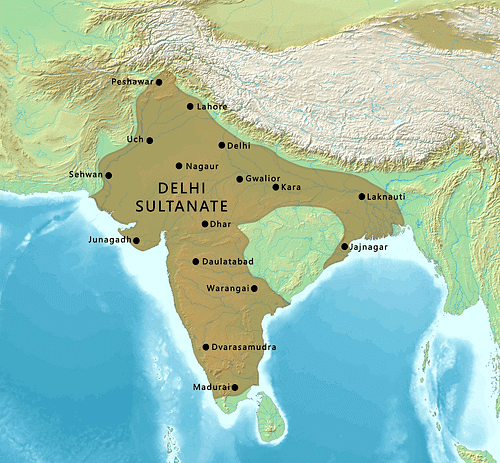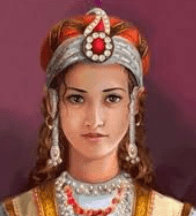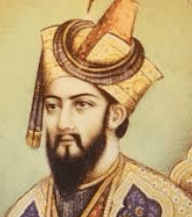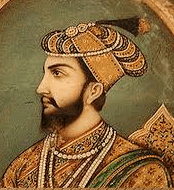Chronology of Kings: The Delhi Sultanate | History for UPSC CSE PDF Download
The Delhi Sultanate was an Islamic empire based in Delhi that stretched over large parts of the Indian subcontinent for 320 years (1206–1526). There was a total of five dynasties that ruled over the Delhi Sultanate sequentially: the Mamluk dynasty (1206–1290), the Khalji dynasty (1290–1320), the Tughlaq dynasty (1320–1414), the Sayyid dynasty (1414–1451), and the Lodi dynasty (1451–1526). On multiple occasions, the entire mass of India was being ruled under the Sultan, sometimes even stretching out to modern-day Pakistan, Bangladesh as well as some parts of southern Nepal. Delhi Sultanate has had a deep impact on the country’s culture and geography, covering large swathes of territory in modern-day India.
What was the Delhi Sultanate?
 Delhi Sultanate
Delhi Sultanate
The Islamic era started with the invasion of Muhammad bin Qasim captured the area of Sind in 712 AD. Initially, India's Islamic rule was fragile but changed drastically with the Turkish invasion.
- Muhammad Ghori was one of the famous names in the Sultan's era. Muhammad Ghori invaded India seven times to expand its rule over the Indian subcontinent, specifically Delhi.
- He fought two battles of Tarain. In the first battle, he lost badly to the era's most powerful Indian ruler, Prithviraj Chauhan.
- In the second battle, he defeated Prithviraj Chauhan. He fought with approximately one lakh soldiers in that battle which outnumbered the Rajput army.
- Thus, Muhammad Ghori is responsible for establishing the Islamic Empire in India. After the death of Muhammad Ghori in 1206 AD, Qutubuddin Aibak, with Mangburni in Central Asia and Yalduz in Lahore, started the Slave dynasty, which marked the beginning of the Delhi Sultanate.
Chronology of Kings
The Sultanate of Delhi (1206-1526) had five ruling dynasties:
The Ilbari (1206-1290)
The Ilbari were a prominent Turkic tribe during the Delhi Sultanate era, playing a significant role in its political landscape. Known for their military prowess and administrative capabilities, they held influential positions within the Sultanate's government, contributing to its stability and expansion during the medieval period in India.
The Khaljis (1290-1320)
The Khaljis were a Turkic dynasty that rose to power during the Delhi Sultanate, ruling from 1290 to 1320. Led by Jalaluddin Khalji and his ambitious nephew, Alauddin Khalji, they established a centralized administration, expanded the empire through military conquests, and introduced significant socio-political reforms, shaping medieval Indian history.
The Tughlaqs (1320-1414)
The Tughlaqs were a powerful dynasty that ruled the Delhi Sultanate in the 14th century. Established by Ghazi Malik, who took the title Ghiyasuddin Tughlaq, they are known for their ambitious military campaigns, administrative reforms, and significant architectural achievements, leaving a lasting impact on medieval Indian history.The Sayyids (1414-51)
The Sayyids ascended to power in the early 15th century (1414–1451). Originating from the Arab world, they established a short-lived dynasty marked by political intrigue and regional instability. Despite their brief reign, they left a notable impact on the Sultanate's political landscape.
The Lodis (1451-1526)
The Lodis were a ruling dynasty in medieval India known for their military conquests and administrative achievements. They expanded their empire from Punjab to Bihar, focusing on infrastructure development like roads and irrigation. However, their rule was marked by religious intolerance, with destruction of temples and re-imposition of taxes on non-Muslims.
Information about the prominent rulers
(A) Qutbuddin Aibak (1206-10)
 Qutub-ud-din Aibak
Qutub-ud-din Aibak
- Establishment of the Slave Dynasty: Qutub-ud-din Aibak, a Turkish slave of Muhammad Ghori, founded the Slave dynasty in India following the Battle of Tarain. He rose to prominence as the governor of Ghori's Indian territories, consolidating Turkish influence in North India.
- Challenges and Triumphs: Aibak faced opposition from Tajuddin Yaldauz and Nasiruddin Qabacha after Ghori's demise. However, through a combination of military prowess and diplomatic finesse, he overcame these challenges, defeating Yaldauz and solidifying his rule.
- Contribution to the Delhi Sultanate: Aibak's reign marked the establishment of the Slave dynasty and the Delhi Sultanate. Renowned for his generosity, he earned the epithet "Lakh Baksh," signifying his charitable donations.
- Architectural Legacy: Lahore served as Aibak's capital, where he initiated the construction of the iconic Qutub Minar, a testament to his architectural patronage. The monument, later completed by Iltumish, stands as a symbol of the Sultanate's grandeur.
- Tragic Demise: Aibak met an untimely death while indulging in his passion for Chaugan, a horse polo game, around 1210 CE, leaving behind a legacy of military conquests and architectural marvels.
- Cultural and Political Context: Firdausi, the celebrated court poet of Mahmud of Ghazni, reflected the cultural milieu of the time. Muhammad-bin-Tughlaq's aphorism, "Sovereignty is not conferred upon every man but is placed on the elect," underscores the political philosophy prevalent during this period.
- Turkish Aesthetics: Turkish artisans adorned architectural marvels with intricate geometrical and floral designs, often accompanied by Quranic inscriptions, showcasing the fusion of art and religion in the Sultanate's cultural landscape.
- The Khalji Revolution: The ascendance of the Khalji dynasty marked a transformative period in Indian history, characterized by the decentralization of power and the dismantling of Turkish racial dictatorship, a shift often referred to as the Khalji Revolution.

(B) Iltutmish (1211-36)
 Iltutmish
Iltutmish
- Rise to Power: Iltutmish, of the Ilbari tribe, was initially sold as a slave to Aibak, who later elevated him by marrying him to his daughter and appointing him as the Iqtadar of Gwalior.
- Ascension to Sultanate: Iltutmish seized power by dethroning Aram Shah, consolidating his rule amidst challenges from rival commanders like Yaldauz and Qabacha.
- Military Victories: Notable victories included defeating Yaldauz in the Battle of Tarain and expelling Qabacha from Punjab, solidifying his authority.
- Political Maneuvering: Iltutmish's refusal to shelter Jalal-ud-din Mangabarni during Genghis Khan's invasion preserved his empire from Mongol onslaught.
- Territorial Expansion: He reestablished control over Bengal and Bihar, quelled Rajput rebellions, and extended his dominion over diverse territories.
- International Recognition: Recognition from the Abbasid Caliph legitimized Iltutmish's sovereignty over India, enhancing his status as a regional power.
- Architectural Legacy: Iltutmish oversaw the completion of the Qutub Minar, symbolizing his architectural patronage and contributing to India's cultural heritage.
- Economic Reforms: Introduction of Arabic coinage, notably the silver tanka, standardized currency in medieval India, bolstering economic stability.
- Administrative Innovations: Iltutmish organized the Turkan-i-Chahalgani, a ruling elite of forty military leaders, known as the Forty, to strengthen governance.
- Cultural Patronage: He fostered intellectual growth by patronizing scholars and embracing Sufi saints, enriching the cultural milieu of his court.
- Succession Planning: Iltutmish nominated his daughter as his successor, paving the way for the continuation of his dynasty.

(C) Razia Sultan (1236-40)
 Raziya Sultan
Raziya Sultan
- Historic Milestone: Raziya Sultan shattered gender norms as medieval India's sole female ruler during the Sultanate era.
- Unconventional Rule: Her appointments, notably of Abyssinian slave Malik Jamal-ud-din Yaqut as master of Royal horses, sparked resentment among Turkish nobles.
- Defiance of Tradition: Raziya's bold actions, like holding court unveiled, hunting, and leading military campaigns, challenged societal expectations.
- Revolt and Capture: Altunia's rebellion led to Raziya's imprisonment after Yaqut's murder, with Turkish nobles installing Bahram Shah as Sultan.
- Marriage and Return: Raziya's alliance with Altunia led to her escape, but Bahram Shah's forces ultimately defeated her, leading to her demise en route to Delhi.

(D) Balban (1266-87)
 Balban
Balban
- Regency Experience: Balban's stint as regent provided insight into Delhi Sultanate's issues, especially the menace posed by "The Forty" nobles.
- Strengthening Monarchy: He advocated bolstering royal authority to combat noble unrest, believing the Sultan to be divinely appointed.
- Authoritarian Rule: Balban enforced strict court etiquette, including prostration and kissing the Sultan's feet, to assert superiority over nobles.
- Turkic Exclusivity: Non-Turks were marginalized from administration, with Balban favoring Turkish nobility for key positions.
- Surveillance System: Introducing a spy network, he monitored nobles' activities closely, eliminating disloyal elements ruthlessly.
- Challenges Faced: Balban tackled internal dissent and external threats, notably Mongol incursions and rebellious governors, prioritizing restoration of law and order.
- Centralization Efforts: He organized a formidable central army and established Diwan-e-arz to address governance and security challenges.
- Balban's Legacy: Despite his efforts, Mongol invasions persisted, and his reign was marred by the revolt of Tughril Khan and the loss of his son in battle.
- Historical Context: Events during Ala-ud-din's reign, such as Mongol invasions and expeditions to secure wealth, shaped the political landscape of the Sultanate.

(E) Ala-ud-din Khalji (1296-1316)
 Ala-ud-din Khalji
Ala-ud-din Khalji
- Conquests: Ala-ud-din Khalji expanded his empire through conquests, seizing territories like Gujarat, Ranthambhor, Chittor, Malwa, Devagiri, and Warangal, with Malik Kafur's conquests extending into the Deccan.
- Military Reforms: His reforms included abolishing the 'Iqtas' system, introducing 'Dagh' for horse branding, and 'Chehra' for soldier identification, and implementing regular army muster.
- Economic Reforms: Ala-ud-din raised land revenue to 50% of produce, resumed land grants, and redirected war booty to the state, instituting a revenue collection department and regulating markets.
- Historical Context: Firuz Shah Tughlaq's promotion of commercial horticulture and Muhammad-bin-Qasim's conquest of Sind under the Umayyad Caliphate illustrate broader historical trends.

(F) Muhammad-bin-Tughlaq (1325-1351)
 Muhammad-bin-Tughlaq
Muhammad-bin-Tughlaq
- Ambitious Schemes and Failures: Muhammad bin Tughlaq's reign was marked by ambitious but ultimately unsuccessful ventures due to their premature implementation.
- Capital Transfer: His attempt to relocate the capital from Delhi to Daulatabad, nearly 1500 kilometers away, resulted in immense suffering and loss of life due to logistical challenges and water scarcity.
- Token Currency: The introduction of copper token currency failed due to widespread forgery and lack of acceptance, leading to financial losses and eventual withdrawal.
- Taxation in Doab: In response to financial setbacks, he imposed heavy land revenue on the farmers of the Doab region, triggering revolts exacerbated by a severe famine.
- Agricultural Reforms: While his agricultural initiatives aimed to boost cultivation through takkavi loans and establishment of a state-run farm, they failed to yield desired results.
- Educational and Religious Tolerance: Despite his failures, Muhammad bin Tughlaq was highly educated and tolerant in religious matters, maintaining diplomatic ties with distant lands and hosting renowned figures like Ibn Batuta.
- Rebellions and Legacy: The latter part of his reign saw numerous rebellions, leading to the establishment of independent kingdoms like Madurai, Vijaynagara, and Bahmani. His death in 1351 marked the beginning of the decline of the Tughlaq dynasty.

(G) Firuz Tughlaq (1351-88)
 Firuz Tughlaq
Firuz Tughlaq
- Ascension to Sultanate: Firoz Shah Tughlaq, chosen by nobles after Muhammad bin Tughlaq's demise, prioritized consolidating power in north India over expanding into the south.
- Military Campaigns: Despite unsuccessful expeditions in Bengal, Firoz Shah's conquests included Jajnagar, Nagarkot, and Thatta, with significant plunder from temples and cultural artifacts.
- Administrative Reforms: Governed with input from ulemas, Firoz Shah revived and made hereditary the iqta system, imposing Islamic taxes and granting hereditary succession to nobles.
- Infrastructure and Economy: Firoz Shah instituted irrigation taxes while constructing extensive canal networks, fostering agriculture and revenue generation. He established royal factories, new towns, and patronized fruit gardens, enhancing economic prosperity.
- Social Welfare and Cultural Patronage: Initiatives like Diwan-i-Khairat supported marginalized groups, while Firoz Shah's patronage of scholars and literature, including his own writings, enriched cultural life.
- Legacy and Succession Struggles: Firoz Shah's death in 1388 marked the onset of power struggles between Sultan and nobles, compounded by the rebellion of slaves created during his reign, challenging subsequent rulers like Muhammad Khan and Ghiyasuddin Tughlaq Shah II.

(H) Sikander Lodi (1489-1517)
 Sikander Lodi
Sikander Lodi
- Military Conquests: The greatest of the Lodhi sovereigns, he expanded his empire significantly, bringing Bihar under his control and defeating numerous Rajput chiefs. His campaigns extended his kingdom from Punjab to Bihar and included a successful attack on Bengal, compelling its ruler to sign a treaty.
- Administrative Achievements: Renowned for his administrative prowess, he constructed roads and implemented irrigation projects for the welfare of peasants. He introduced the Gaz-i-Sikandari measurement system and enhanced accounting practices.
- Bigotry and Intolerance: Despite his administrative successes, he displayed intolerance towards non-Muslims, leading to the destruction of many temples and the re-imposition of Jizya tax on non-Muslims.
- Founding of Agra: In circa 1504 CE, he founded the city of Agra, leaving a lasting legacy. Additionally, he composed Persian verses under the pseudonym Gulrakhi, showcasing his cultural interests.

The Delhi Sultanate, spanning over three centuries (1206–1526), marked a significant era in Indian history. It saw the rise and fall of five dynasties—Slave, Khalji, Tughlaq, Sayyid, and Lodi. This period was pivotal for the establishment of Islamic rule, cultural fusion, and administrative innovations in India. Despite internal conflicts and invasions, the Sultanate strengthened trade, introduced Persian culture, and laid the foundation for later empires. Its decline paved the way for the Mughal Empire. The Delhi Sultanate's legacy is a blend of resilience, architectural marvels, and the cultural diversity that continues to influence India's socio-political landscape today.
|
122 videos|653 docs|168 tests
|
FAQs on Chronology of Kings: The Delhi Sultanate - History for UPSC CSE
| 1. What was the Delhi Sultanate and its significance in Indian history? |  |
| 2. Who were the prominent rulers of the Ilbari dynasty and what are their contributions? |  |
| 3. What were the key achievements of the Khalji dynasty during their reign? |  |
| 4. How did the Tughlaq dynasty influence the Delhi Sultanate? |  |
| 5. What led to the decline of the Delhi Sultanate and the rise of the Mughal Empire? |  |

















